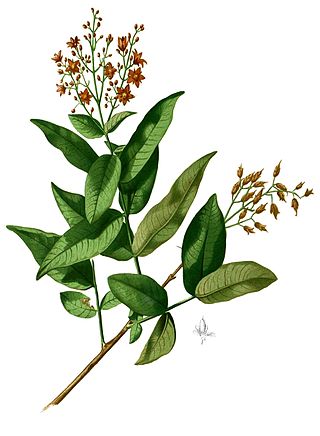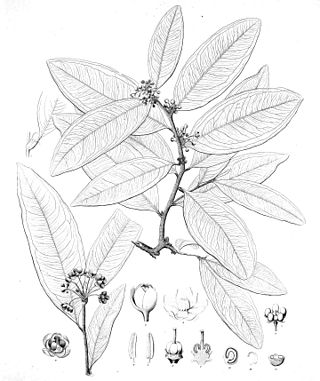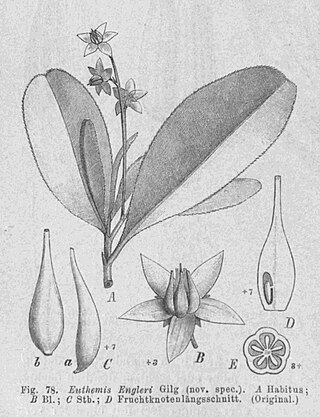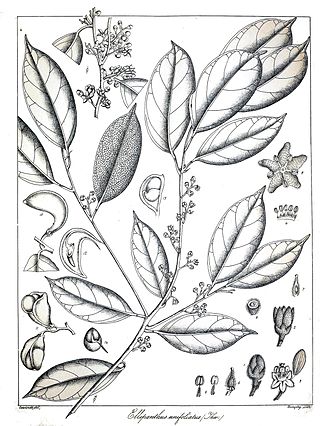
Cratoxylum is a genus of flowering plants in the family Hypericaceae, native to tropical Asia. The generic name means "strong wood", referring to the timber.

Cratoxylum arborescens is a plant in the family Hypericaceae. The specific epithet arborescens is from the Latin meaning "tree-like".

Anisophyllea is a genus of plant in the family Anisophylleaceae. The generic name is from the Greek meaning "unequal leaf", referring to the dimorphism of the leaves.
Anisophyllea disticha is a plant of tropical Asia in the family Anisophylleaceae. The specific epithet disticha is from the Latin meaning "2-ranked", referring to the leaf arrangement.

Brackenridgea is a flowering plant genus of 11 species in the family Ochnaceae. The genus is named for the British-American botanist William Dunlop Brackenridge.
Cassine viburnifolia is a species of mangrove plant of tropical Asia in the staff vine family Celastraceae. The specific epithet viburnifolia refers to how the plant's leaves resemble those of the genus Viburnum.

Euthemis minor is a plant in the family Ochnaceae. The specific epithet minor is from the Latin meaning "small", referring to the species' smaller size when compared with E. leucocarpa.

Campylospermum serratum is a plant in the family Ochnaceae. The specific epithet serratum is from the Latin meaning "with teeth", referring to the leaf margin. It is found in Tropical Asia, from Sulawesi, Indonesia to Hainan, Zhōngguó/China and over to southwestern India. Gomphia serrata was a previous common name for the species. The plant is used for its wood and its sap is used in folk medicine and in the past for teeth-blackening.
Heliciopsis is a genus of about fourteen species of trees, constituting part of the flowering plant family Proteaceae. They grow naturally in Myanmar, Indo-China, China, Thailand, Peninsular Malaysia, Borneo, Sumatra, Java (Indonesia) and the Philippines. The name means similar to the plant genus Helicia. Its closest relatives are Athertonia (Australia) and Virotia.
Kibara coriacea is a plant in the family Monimiaceae. The specific epithet coriacea is from the Latin meaning "leathery", referring to the leaves.

Dryobalanops is a genus of flowering plants and the genus of family Dipterocarpaceae. The name Dryobalanops is derived from Greek and describes the acorn-like nut. The genus has seven species, confined to the tropical forests of western Malesia. It is among the most abundant species of emergent trees in these forests, growing up to 80 m tall.
Diospyros venosa is a tree in the family Ebenaceae. It is native to Southeast Asia, from the Maluku Islands to Myanmar. It provides raw material for handicrafts, traditional medicine and fuel.
Didymocheton mollissimus is a species of tree in the family Meliaceae. It ranges from eastern India and Bangladesh to southern China, Myanmar, Thailand, Peninsular Malaysia, Borneo, Sumatra, Java, the Lesser Sunda Islands, and the Philippines, where it grows in lowland tropical moist forests.
Combretocarpus is a monotypic genus of tree in the Anisophylleaceae family. The generic name combretocarpus is from the Greek, referring to the resemblance of its fruit to that of the genus Combretum. As of April 2014 The Plant List recognises the single species Combretocarpus rotundatus.
Parinari canarioides is a tree in the family Chrysobalanaceae. The specific epithet canarioides is for the species' resemblance to the genus Canarium.

Ellipanthus is a genus of plants in the family Connaraceae. The generic name is from the Greek meaning "defective flower", referring to the incomplete development of some of the stamens.

Euthemis leucocarpa is a plant in the family Ochnaceae. The specific epithet leucocarpa is from the Greek meaning 'white fruit'.

Kandelia is a plant genus of two species in the mangrove family Rhizophoraceae.
Androtium is a monotypic genus of trees in the cashew or sumac family Anacardiaceae. It contains the single species Androtium astylum. The generic name Androtium is from the Greek meaning "male ear-lobe", referring to the shape of the lobe of the stamen. The specific epithet astylum is from the Latin meaning "without style", referring to the plant's ovary.

Drimycarpus is a small genus of trees in the cashew and sumac family Anacardiaceae. The generic name is from the Greek meaning "pungent fruit".









